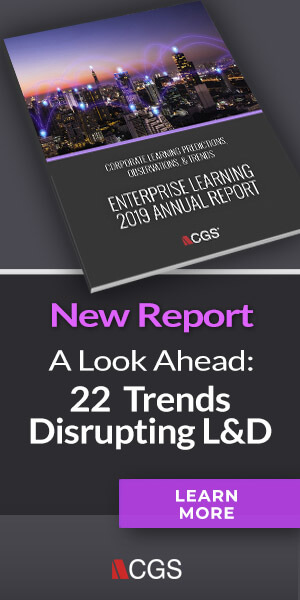
Lori Niles-Hofmann is a senior learning strategist with over 20 years of L&D experience across many industries, including international banking, management consulting, and marketing. Her specialization is large-scale digital learning transformations and she is passionate about helping companies navigate through the ambiguity of change. She is the author of Data-Driven Learning Design, How to Decode Learner Digital Body Language.
Topics
Reaction to the 2019 CGS Learning Trends Report: 4 Stats to Help L&D Navigate the Future

They say the definition of insanity is doing the same thing over and over again, expecting a different result. If that is true, then we may all be well and truly crazy in L&D. This was my initial reaction as I dove into reading this year’s Enterprise Learning Annual Report by CGS. The report itself is very comprehensive. It makes for compelling reading and should be referred to as a bellwether for all L&D leaders questioning how to navigate the future. However, we are making the same basic errors year after year.
After a first read of the report, I went through my archives and dug up an old conference flyer from 2001 The keynote topic was: How learning departments need to collaborate with the business and learning in the new digital era. Now, 18 years have passed and according to the report results, we are not much further along. It is time to get it right.
If this sounds like fear mongering, consider the following highlight:
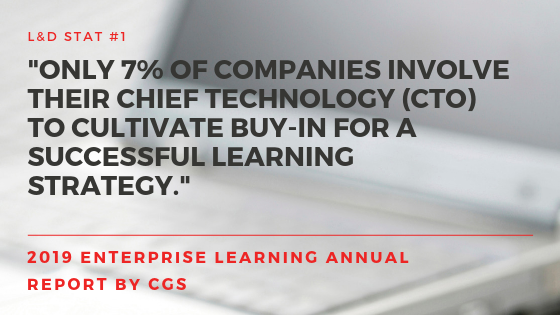
Most companies are embarking on a digital learning transformation, so strong partnerships with IT are paramount to success. You do not build a house without consulting an architect, so buy your CTO a cup of coffee and be prepared to listen. The CTO will probably have valuable advice and insight. And if he does, get a croissant to go with that latte.
The CTO was not the only one ignored. It was eye-opening to note only 35% of CEOs contribute to the decision-making process of learning initiatives.
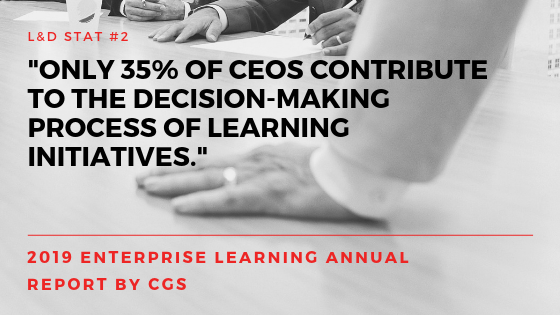
Learning strategies can cost millions and impact every single employee and yet, 65% of us do not have the ear of the CEO. L&D should be as important as Finance, Risk or IT. Yes, it can be challenging to get face time with the C-Suite, so when you do, be ready to deliver your value-add in under three minutes. Practice beforehand, get feedback, and focus on business metrics. This will elevate you beyond a cost center.
Another striking statistic is that only 8% of companies have a continuous feedback loop.
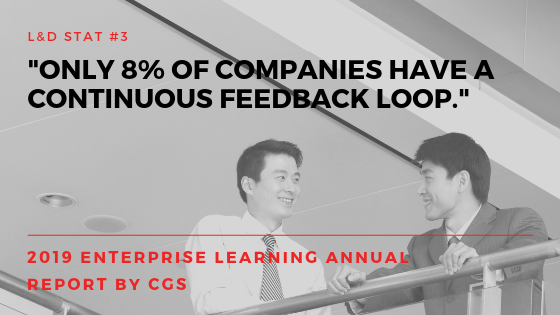
As L&D is called upon to be more agile and proactive to business needs, the key to success is in mining, understanding and responding to data insights daily. As Yvette Cameron, a leading HCM tech advisor and industry analyst, points out, we should analyze learner engagement in the same ways customer sentiment analysis is conducted today. This would empower better decision-making and business impact. Yes, 53% rely on the annual survey, which is not where we need to be. Imagine if companies only listened to customers once a year? They would go bankrupt. Look to any and all data sources, even beyond the LMS, to understand learner needs and engagement.
This disconnect between the learner expectations and L&D decisions is also demonstrated in content development. It is no surprise that mobile, micro-learning and video, are top of the list for budget investment. Yet employees state Instructor-Led Training (ILT) is still their preferred modality.
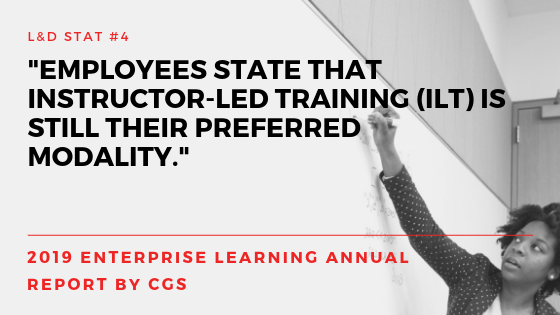
Only 13% of companies are investing in it and nearly a quarter of companies are reducing ILT budgets. Of course, there is always the argument that classroom training is far more expensive than digital. However, with learning being the top consideration outside of salary, we either need to drastically improve our quality of digital learning or reconsider face-to-face learning to be competitive in talent attraction, especially as skills become rarer to find. So, do not bulldozer the classroom yet.
Interestingly, 70% of companies said they had no plans to invest in augmented reality (AR), and only 5% currently have AR as a viable part of their training curricula. This is a stark contrast to the amount of conversation and hype around the tools available. This is not to suggest a dismissal of the media, but more a reflection of the top challenge indicated by L&D professionals, in that; they have limited resources.
L&D is a tough business. There is a lot of noise and disruption, and we are expected to be all things to all aspects of the business. That said, if someone from another industry read this report, it would be obvious to them that many of our largest barriers are self-inflicted and solvable. We simply need to reach out more and, more importantly, listen to and communicate what we are hearing from our partners and learners.
Additional Resources:
- Webinar: Elevate Performance and Business Strategy
- Article: 4 Steps to Refresh Your Learning Strategy for 2019
- Article: Feedback as Proof of ROI: Best Practices for Using Qualitative Data to Complement L&D ROI

Lori Niles-Hofmann is a senior learning strategist with over 20 years of L&D experience across many industries, including international banking, management consulting, and marketing. Her specialization is large-scale digital learning transformations and she is passionate about helping companies navigate through the ambiguity of change. She is the author of Data-Driven Learning Design, How to Decode Learner Digital Body Language.


